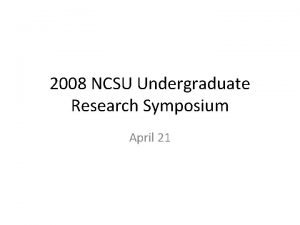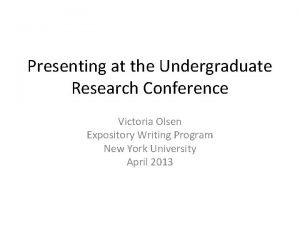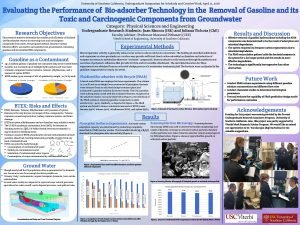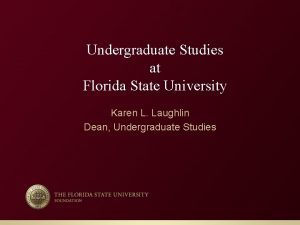Wyoming NSFEPSCo R Undergraduate Research Fellowship Nanoindentation of















- Slides: 15

Wyoming NSF/EPSCo. R Undergraduate Research Fellowship Nanoindentation of Polymers Ashley Bucsek Nano- and Micro-Mechanics Laboratory members: Chung-Souk Han, Ph. D. Nitin Garg Farid Alisafaei Seyed Hamid Reza Sanei Rajib Krishna Shasa

Background│ Hypotheses │Instrumentation │ Procedure │ Results │ Discussion │ Current Research Small-scale polymers § Coatings and adhesives § Micromechanical devices § Biomedical microdevices § Composites Boisen, A. et al. (2011). [Figure 8] “Cantilever-like micromechanical sensors, ” Reports on Progress in Physics, 74. Ø Engineers use mechanical properties to safely predict the behavior of objects under applied loads. Ø It is important to understand the properties of polymers at very small scales.

Background│ Hypotheses │Instrumentation │ Procedure │ Results │ Discussion │ Current Research Hardness: the resistance of a material to permanent penetration by another significantly harder material On the macroscale, material properties like hardness are constant.

Background│ Hypotheses │Instrumentation │ Procedure │ Results │ Discussion │ Current Research Indentation Size Effects (ISE): the apparent increase in material-specific properties at very small scales Metals § ISE well documented, well understood Polymers § ISE not well document, not well understood Research § Study ISE in polymers, using polydimethylsiloxane (PDMS) § Improve the understanding of ISE in polymers § Help develop physically based theories to model and explain ISE in polymers

Background│ Hypotheses │Instrumentation │ Procedure │ Results │ Discussion │ Current Research 1. ISE can be observed in PDMS. 2. These ISE vary with different cross-link densities. cross links Callister, W. (2010). [Figure 14. 7] “Materials Science and Engineering: An Introduction, 8 th ed. ”

Background│ Hypotheses │ Instrumentation │ Procedure │ Results │ Discussion │ Current Research Nanoindenter tip under a load, F, displacing a material to an indentation depth, h G 200 Nano Indenter™ Berkovich indenter tip

Background│ Hypotheses │ Instrumentation │ Procedure │ Results │ Discussion │ Current Research Parameters § Time to Load Hold Time § Surface Approach Sensitivity, Ktol Time to Load § Hold Time § Maximum Load, Fmax Results § Maximum Indentation Depth, hmax § Permanent Indentation Depth, hf

Background│ Hypotheses │Instrumentation │ Procedure │ Results │ Discussion │ Current Research Cross-Link Densities § 2. 5% § 10% Parameters § § Time to Load: 5 seconds Hold Time: 0 seconds Surface Approach Sensitivity, Ktol: 50 N/m Maximum Load, Fmax: 0. 3 m. N to 45 m. N Berkovich Tip Sizes § 0. 3 m. N to 10 m. N: “Berkovich ISO Tip” § 8 m. N to 45 m. N: “Berkovich MACRO Tip”

Background│ Hypotheses │Instrumentation │ Procedure │ Results │ Discussion │ Current Research 1 2 1. 2. ISO 14577 -1 Metallic materials – Instrumented indentation test for hardness and materials parameters – Part 1: test method. International Organization for Standardization (2002). Sneddon, I. "The relation between load and penetration in the axisymmetric boussinesq problem for a punch of arbitrary profile. " Int. J. Eng. Sci. 3. (1965): 47 -57.

Background│ Hypotheses │Instrumentation │ Procedure │ Results │ Discussion │ Current Research Two important characteristics: 1. Drastic increase with decreasing indentation depths below 90 µm 2. Reach transient quantity as indentation depths increase above 90 µm Indentation Size Effects

Background│ Hypotheses │Instrumentation │ Procedure │ Results │ Discussion │ Current Research

Background│ Hypotheses │Instrumentation │ Procedure │ Results │ Discussion │ Current Research

Background│ Hypotheses │Instrumentation │ Procedure │ Results │ Discussion │ Current Research Elastic Modulus § The material property, elastic modulus, does not actually increase. § Has been shown to be constant by lab member, Seyed Hamid Reza Sanei. § The problem is how the test results are used to calculate elastic modulus. § Classical continuum theories do not account for strain gradients. spherical indenter tip Ø This research will help shed light on the shortcomings of classical continuum theory.

Background│ Hypotheses │Instrumentation │ Procedure │ Results │ Discussion │ Current Research Unanswered Question: How does ISE vary with crosslink density? Current Project Goals: 1. Determine appropriate surface approach sensitivity criteria, Ktol. 2. Repeat testing for 2. 5%, and 10% with new Ktol. 3. Repeat experimental procedure for epoxy. 4. Interpret for a manuscript to be submitted for publication in an international scientific journal.

Background│ Hypotheses │Instrumentation │ Procedure │ Results │ Discussion │ Current Research Thank you for your attention. Special Thanks to Dr. Han and EPSCo. R. Questions?
 King's undergraduate research fellowship
King's undergraduate research fellowship Ncsu undergraduate research symposium
Ncsu undergraduate research symposium Nyu undergraduate research conference
Nyu undergraduate research conference Acu undergraduate research festival
Acu undergraduate research festival Mrc career development award
Mrc career development award Portland state university undergraduate tuition and fees
Portland state university undergraduate tuition and fees Baccalaureate degree meaning
Baccalaureate degree meaning Difference between postgraduate and undergraduate
Difference between postgraduate and undergraduate Unb undergraduate calendar
Unb undergraduate calendar University of southern california undergraduate
University of southern california undergraduate Acadia university undergraduate programs
Acadia university undergraduate programs Ics student services
Ics student services Temple university undergraduate bulletin
Temple university undergraduate bulletin Difference between postgraduate and undergraduate
Difference between postgraduate and undergraduate Dean of undergraduate studies fsu
Dean of undergraduate studies fsu Undergraduate graduate postgraduate
Undergraduate graduate postgraduate





























